2022 TOYOTA SUPRA check engine
[x] Cancel search: check enginePage 287 of 498

285
4
4-1. DRIVING HINTS
DRIVING HINTS
Ensure that you do not obstruct
other road users when doing so.
The heat generated by braking
dries the brake discs and brake
pads and protects them against
corrosion.
This way, brake power is available
immediately, whenever it is needed.
■General
When driving on long or steep
downhill stretches, use the gear in
which the least braking is required.
Otherwise the brake system can
overheat and the braking effect is
reduced.
Engine braking effect can be addi-
tionally increased by manually shift-
ing down, even into first gear, if
applicable.
■Safety notes
Corrosion of the brake discs and
contamination of the brake pads
increase in the following circum-
stances:
Low mileage.
Extended periods when the vehi-
cle is not used.
Infrequent use of the brakes.
Aggressive, acidic or alkaline
cleaning agents.
During braking, corroded brake
discs may cause brake judder
which usually cannot be eliminated.
When the automatic air condition-
ing is in operation, condensation
develops and exits underneath the
vehicle.
The higher mechanical and thermal
loads involved in driving on racing
tracks lead to increased wear. This
wear is not covered by the war-
ranty. The vehicle is not conceived
for use in motor sports competi-
tions.
Before and after driving on a racing
track, have the vehicle checked at
any authorized Toyota retailer or
Toyota authorized repairer, or any
reliable repairer.
Downhill gradients
WA R N I N G
Even slight continuous pressure on the brake pedal can cause overheat-
ing, brake pad wear or even brake
system failure. There is a danger of accidents. Avoid excessive loads on
the brake.
WA R N I N G
When idling or with the engine switched off, safety-relevant func-
tions, for example engine braking
effect or steering and braking force assistance, are either restricted or not
available at all. There is a risk of acci-
dent. Do not drive at idle speed or with the engine switched off.
Corrosion of the brake discs
Condensation when vehicle
is parked
Driving on a racing track
Page 288 of 498
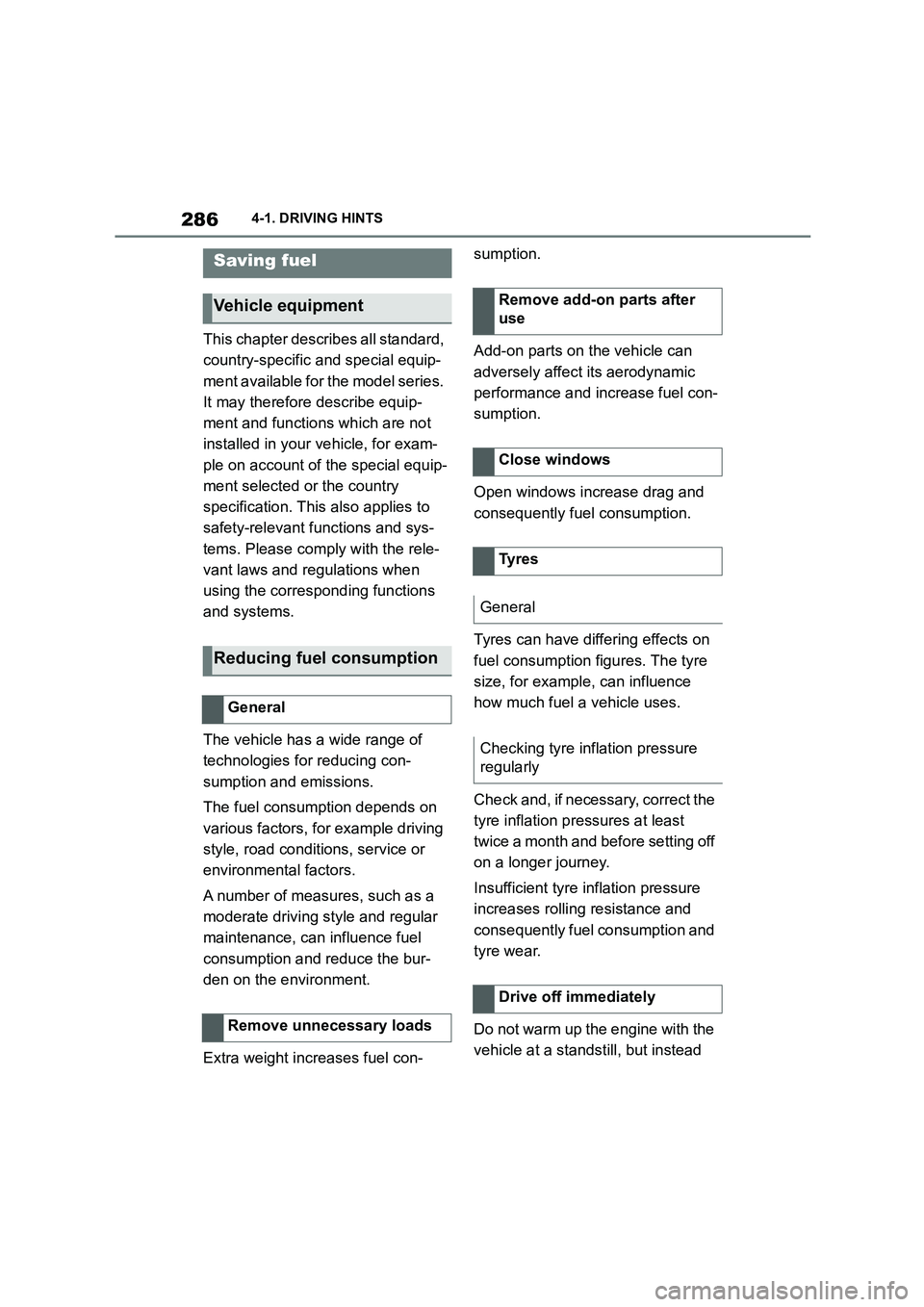
2864-1. DRIVING HINTS
This chapter describes all standard,
country-specific and special equip-
ment available for the model series.
It may therefore describe equip-
ment and functions which are not
installed in your vehicle, for exam-
ple on account of the special equip-
ment selected or the country
specification. This also applies to
safety-relevant functions and sys-
tems. Please comply with the rele-
vant laws and regulations when
using the corresponding functions
and systems.
The vehicle has a wide range of
technologies for reducing con-
sumption and emissions.
The fuel consumption depends on
various factors, for example driving
style, road conditions, service or
environmental factors.
A number of measures, such as a
moderate driving style and regular
maintenance, can influence fuel
consumption and reduce the bur-
den on the environment.
Extra weight increases fuel con-
sumption.
Add-on parts on the vehicle can
adversely affect its aerodynamic
performance and increase fuel con-
sumption.
Open windows increase drag and
consequently fuel consumption.
Tyres can have diff ering effects on
fuel consumption figures. The tyre
size, for example, can influence
how much fuel a vehicle uses.
Check and, if necessary, correct the
tyre inflation pressures at least
twice a month and before setting off
on a longer journey.
Insufficient tyre inflation pressure
increases rolling resistance and
consequently fuel consumption and
tyre wear.
Do not warm up the engine with the
vehicle at a stands till, but instead
Saving fuel
Vehicle equipment
Reducing fuel consumption
General
Remove unnecessary loads
Remove add-on parts after
use
Close windows
Ty r e s
General
Checking tyre inflation pressure
regularly
Drive off immediately
Page 304 of 498
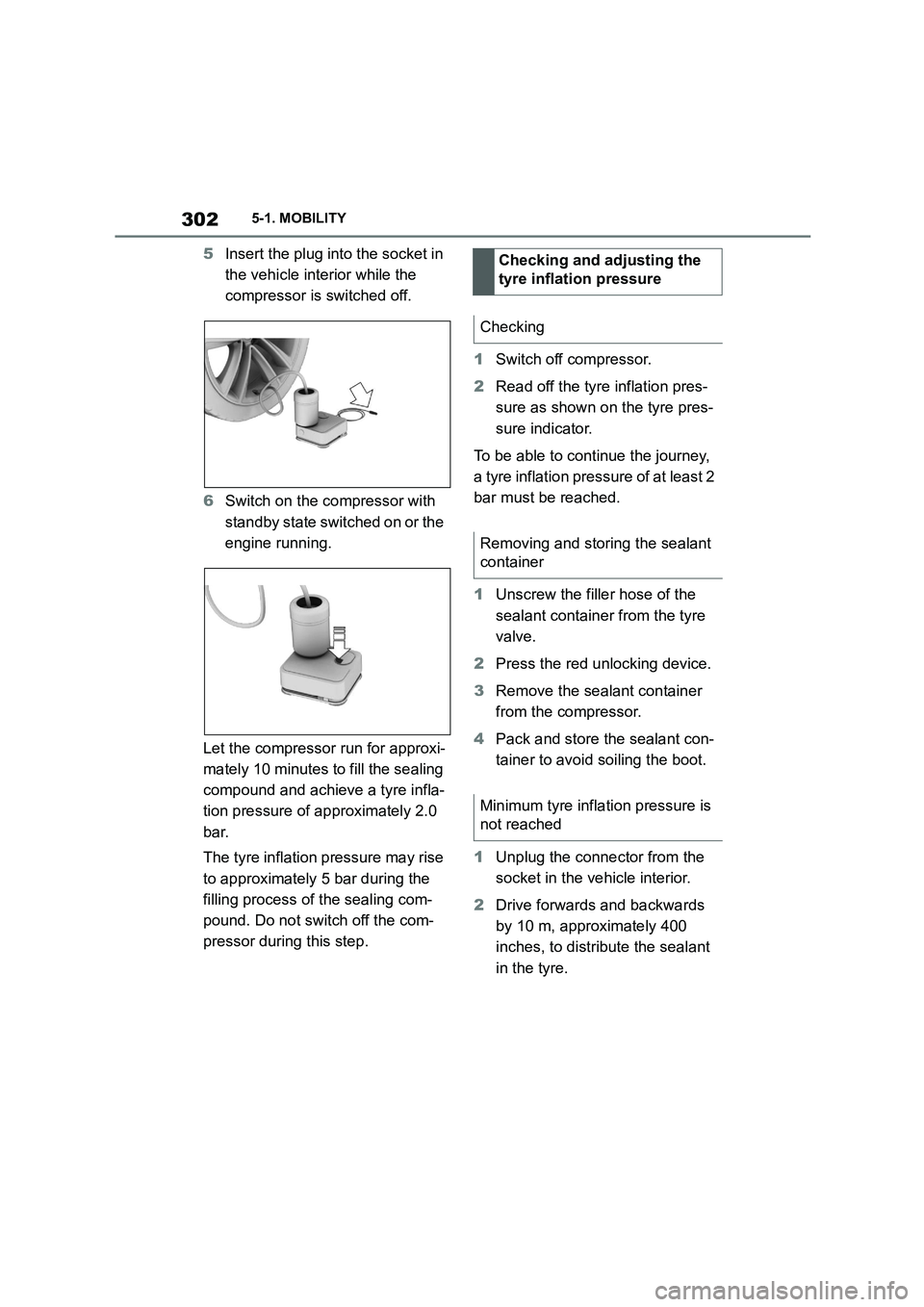
3025-1. MOBILITY
5Insert the plug into the socket in
the vehicle interior while the
compressor is switched off.
6 Switch on the compressor with
standby state switched on or the
engine running.
Let the compressor run for approxi-
mately 10 minutes to fill the sealing
compound and achieve a tyre infla-
tion pressure of approximately 2.0
bar.
The tyre inflation pressure may rise
to approximately 5 bar during the
filling process of the sealing com-
pound. Do not switch off the com-
pressor during this step.
1 Switch off compressor.
2 Read off the tyre inflation pres-
sure as shown on the tyre pres-
sure indicator.
To be able to continue the journey,
a tyre inflation pressure of at least 2
bar must be reached.
1 Unscrew the filler hose of the
sealant container from the tyre
valve.
2 Press the red unlocking device.
3 Remove the sealant container
from the compressor.
4 Pack and store the sealant con-
tainer to avoid soiling the boot.
1 Unplug the connector from the
socket in the vehicle interior.
2 Drive forwards and backwards
by 10 m, approximately 400
inches, to distribute the sealant
in the tyre.
Checking and adjusting the
tyre inflation pressure
Checking
Removing and storing the sealant
container
Minimum tyre inflation pressure is
not reached
Page 325 of 498
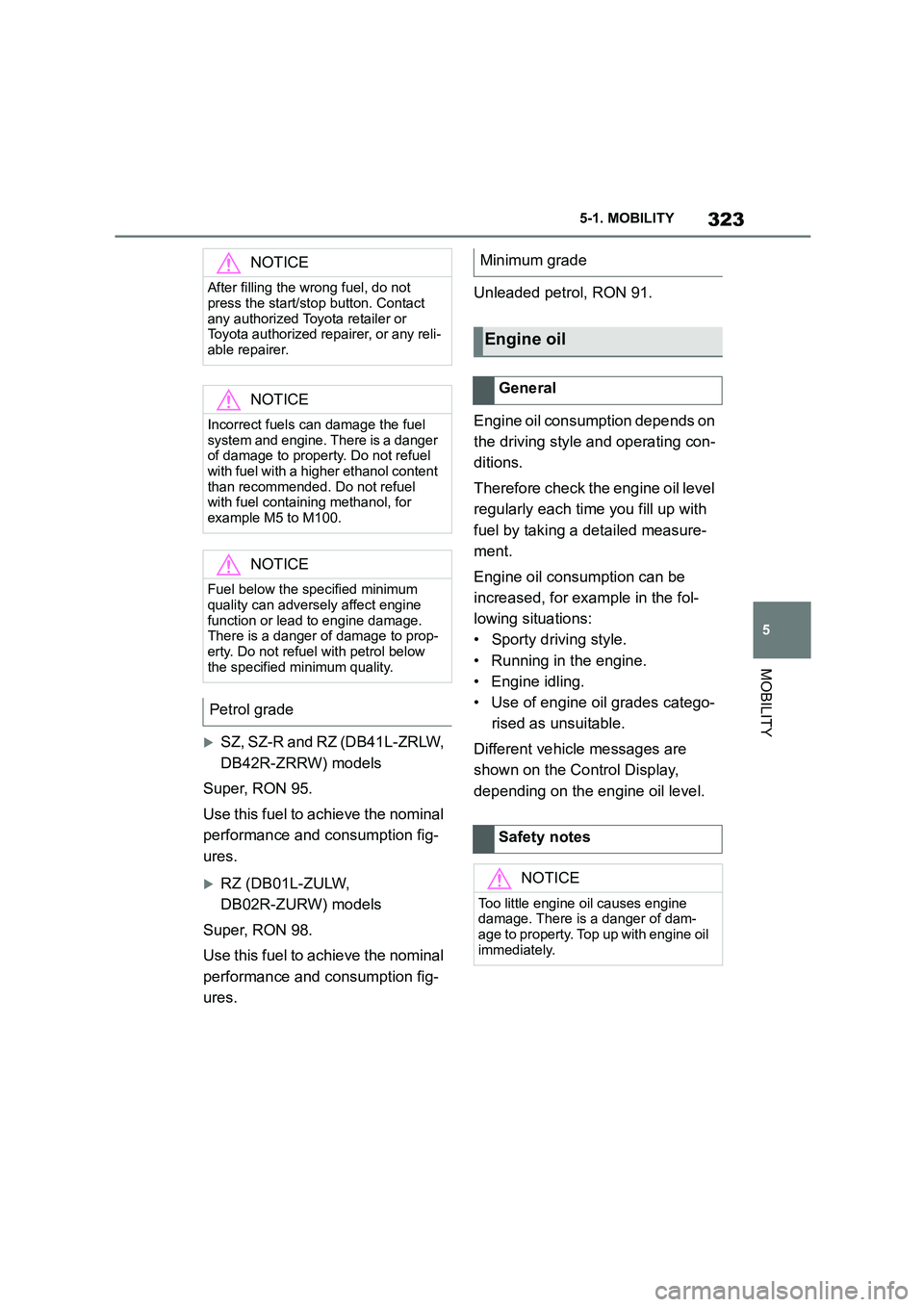
323
5
5-1. MOBILITY
MOBILITY
SZ, SZ-R and RZ (DB41L-ZRLW,
DB42R-ZRRW) models
Super, RON 95.
Use this fuel to achieve the nominal
performance and consumption fig-
ures.
RZ (DB01L-ZULW,
DB02R-ZURW) models
Super, RON 98.
Use this fuel to achieve the nominal
performance and consumption fig-
ures.
Unleaded petrol, RON 91.
Engine oil consumption depends on
the driving style and operating con-
ditions.
Therefore check the engine oil level
regularly each time you fill up with
fuel by taking a detailed measure-
ment.
Engine oil consumption can be
increased, for example in the fol-
lowing situations:
• Sporty driving style.
• Running in the engine.
• Engine idling.
• Use of engine oil grades catego-
rised as unsuitable.
Different vehicle messages are
shown on the Control Display,
depending on the engine oil level.
NOTICE
After filling the wrong fuel, do not
press the start/stop button. Contact
any authorized Toyota retailer or Toyota authorized repairer, or any reli-
able repairer.
NOTICE
Incorrect fuels can damage the fuel
system and engine. There is a danger of damage to property. Do not refuel
with fuel with a higher ethanol content
than recommended. Do not refuel with fuel containing methanol, for
example M5 to M100.
NOTICE
Fuel below the specified minimum quality can adversely affect engine
function or lead to engine damage.
There is a danger of damage to prop- erty. Do not refuel with petrol below
the specified minimum quality.
Petrol grade
Minimum grade
Engine oil
General
Safety notes
NOTICE
Too little engine oil causes engine
damage. There is a danger of dam- age to property. Top up with engine oil
immediately.
Page 326 of 498

3245-1. MOBILITY
Electronic oil measurement uses
two measuring methods:
• Monitoring.
• Detailed measurement.
When frequently making short trips
or using a sporty driving style, for
example taking corners at high
speed, regularly perform a detailed
measurement.
■Principle
The engine oil level is electronically
monitored during the journey and
can be shown on the Control Dis-
play.
If the engine oil level is outside its
permissible operating range, a
vehicle message is shown.
■Operating requirements
A current measurement is available
after approximately 30 minutes of
normal driving.
■Displaying the engine oil level
Via Toyota Supra Command:
1 "My Vehicle"
2 "Vehicle status"
3 "Engine oil level"
The engine oil level is displayed.
■System limits
When frequently making short trips
or using a sporty driving style, it
may not be possible to measure the
oil level. In this case, the measure-
ment for the last, sufficiently long
journey is displayed.
■Principle
The engine oil level is checked
when the vehicle is stationary and
is shown on a scale.
If the engine oil level is outside its
permissible operating range, a
vehicle message is shown.
■General
During measurement, the idle
speed is slightly raised.
■Operating requirements
• Vehicle is standing horizontally.
• Selector lever in selector lever
position N or P and accelerator
pedal not pressed.
• Engine is running and is at oper-
NOTICE
Too much engine oil can damage the
engine or the catalytic converter.
There is a danger of damage to prop- erty. Do not top up with too much
engine oil. If there is too much engine
oil, have the engine oil level corrected by any authorized Toyota retailer or
Toyota authorized repairer, or any reli-
able repairer.
Electronic oil measurement
General
Monitoring
A red indicator lamp is dis-
played if the engine oil
pressure is insufficient.
Detailed measurement
Page 327 of 498
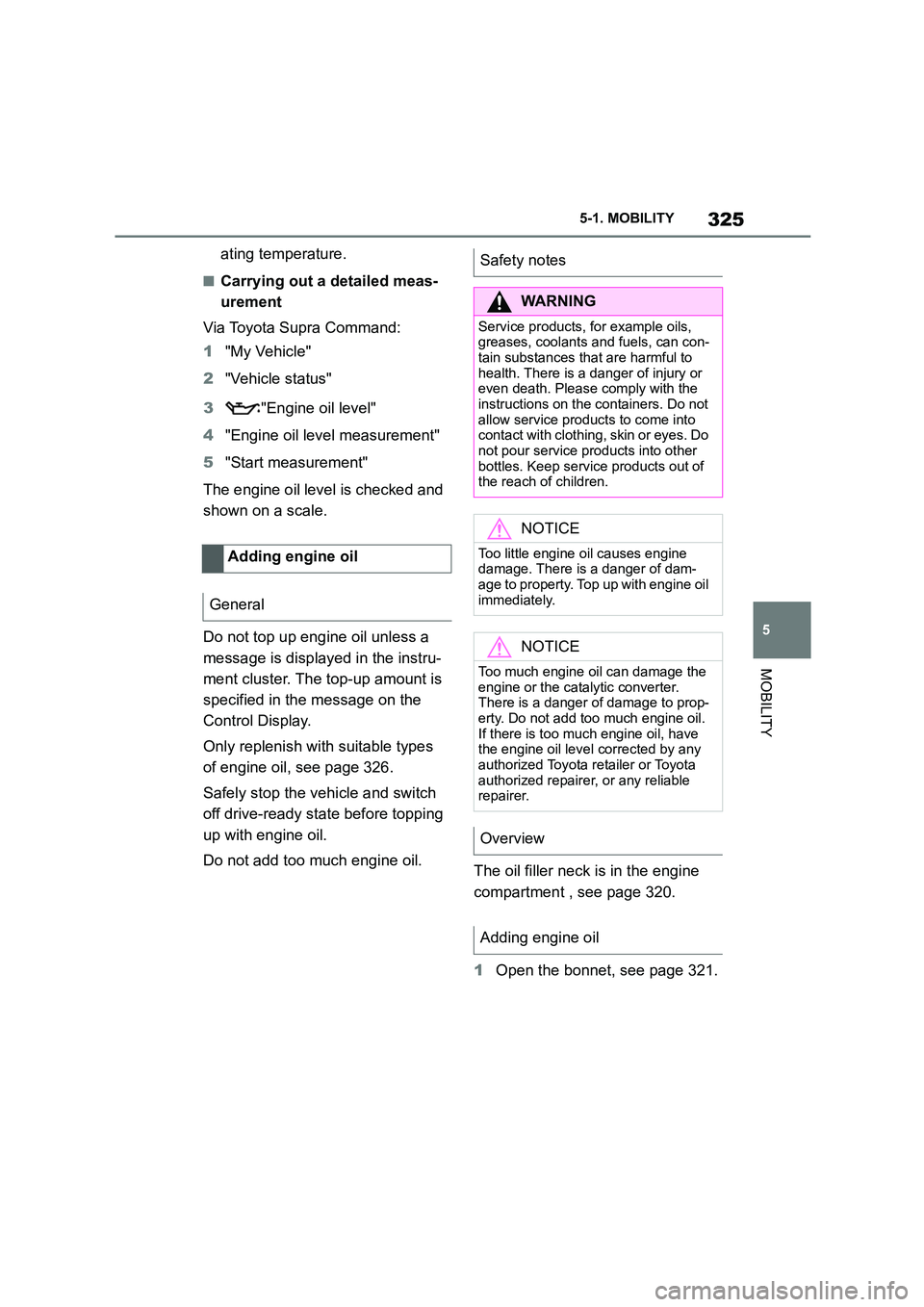
325
5
5-1. MOBILITY
MOBILITY
ating temperature.
■Carrying out a detailed meas-
urement
Via Toyota Supra Command:
1 "My Vehicle"
2 "Vehicle status"
3 "Engine oil level"
4 "Engine oil level measurement"
5 "Start measurement"
The engine oil level is checked and
shown on a scale.
Do not top up engine oil unless a
message is displayed in the instru-
ment cluster. The top-up amount is
specified in the message on the
Control Display.
Only replenish with suitable types
of engine oil, see page 326.
Safely stop the vehicle and switch
off drive-ready state before topping
up with engine oil.
Do not add too much engine oil. The oil filler neck is in the engine
compartment , see page 320.
1 Open the bonnet, see page 321.
Adding engine oil
General
Safety notes
WA R N I N G
Service products, for example oils,
greases, coolants and fuels, can con- tain substances that are harmful to
health. There is a danger of injury or
even death. Please comply with the instructions on the containers. Do not
allow service products to come into
contact with clothing, skin or eyes. Do
not pour service products into other bottles. Keep service products out of
the reach of children.
NOTICE
Too little engine oil causes engine
damage. There is a danger of dam-
age to property. Top up with engine oil immediately.
NOTICE
Too much engine oil can damage the
engine or the catalytic converter. There is a danger of damage to prop-
erty. Do not add too much engine oil.
If there is too much engine oil, have the engine oil level corrected by any
authorized Toyota retailer or Toyota
authorized repairer, or any reliable repairer.
Overview
Adding engine oil
Page 329 of 498
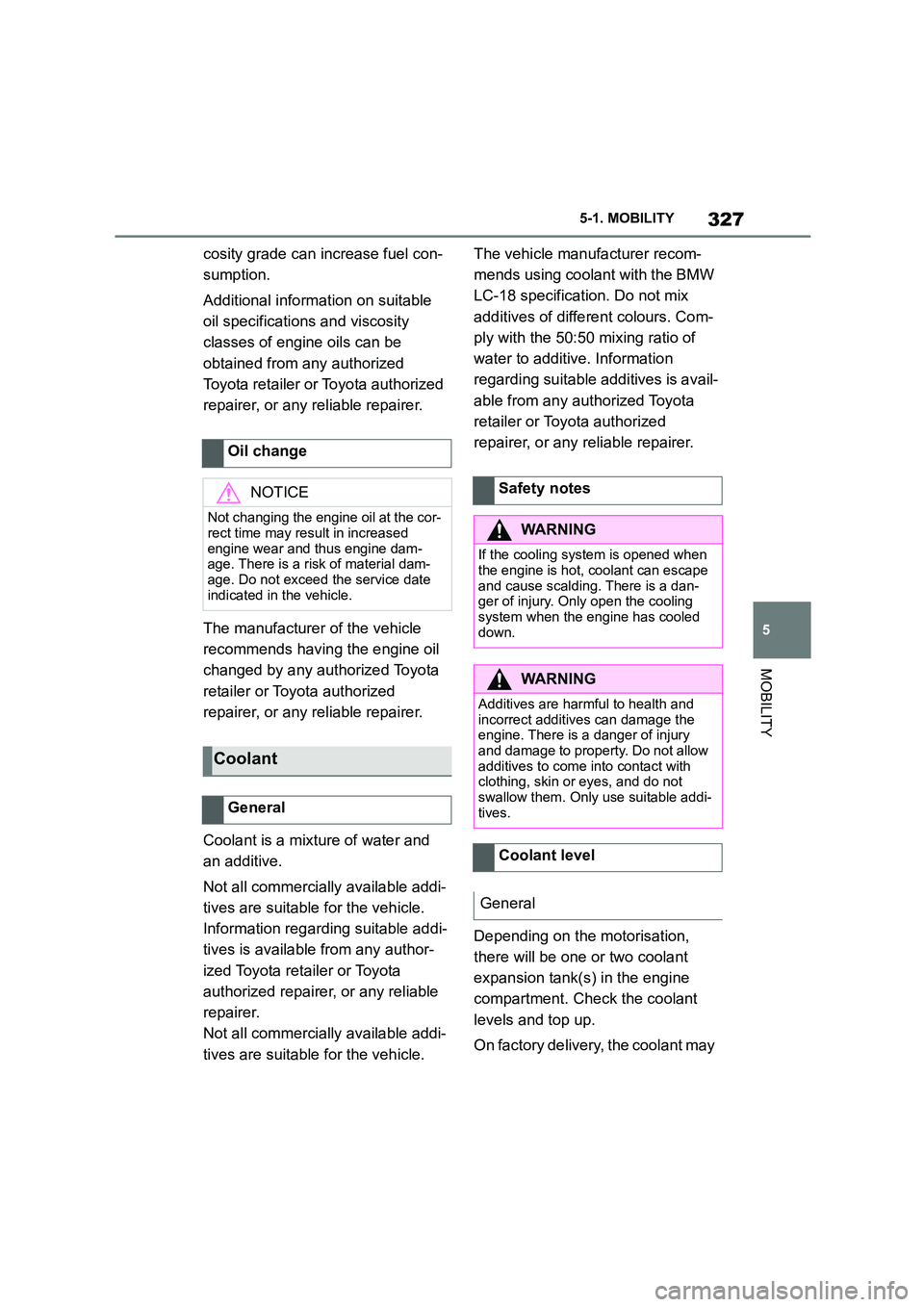
327
5
5-1. MOBILITY
MOBILITY
cosity grade can increase fuel con-
sumption.
Additional information on suitable
oil specifications and viscosity
classes of engine oils can be
obtained from any authorized
Toyota retailer or Toyota authorized
repairer, or any reliable repairer.
The manufacturer of the vehicle
recommends having the engine oil
changed by any authorized Toyota
retailer or Toyota authorized
repairer, or any reliable repairer.
Coolant is a mixture of water and
an additive.
Not all commercially available addi-
tives are suitable for the vehicle.
Information regarding suitable addi-
tives is available from any author-
ized Toyota reta iler or Toyota
authorized repairer, or any reliable
repairer.
Not all commercially available addi-
tives are suitable for the vehicle.
The vehicle manufacturer recom-
mends using coolant with the BMW
LC-18 specification. Do not mix
additives of different colours. Com-
ply with the 50:50 mixing ratio of
water to additive. Information
regarding suitable additives is avail-
able from any authorized Toyota
retailer or Toyota authorized
repairer, or any reliable repairer.
Depending on the motorisation,
there will be one or two coolant
expansion tank(s) in the engine
compartment. Check the coolant
levels and top up.
On factory delivery, the coolant may
Oil change
NOTICE
Not changing the engine oil at the cor-
rect time may result in increased
engine wear and thus engine dam- age. There is a risk of material dam-
age. Do not exceed the service date
indicated in the vehicle.
Coolant
General
Safety notes
WA R N I N G
If the cooling system is opened when
the engine is hot, coolant can escape
and cause scalding. There is a dan- ger of injury. Only open the cooling
system when the engine has cooled
down.
WA R N I N G
Additives are harmful to health and
incorrect additives can damage the
engine. There is a danger of injury and damage to property. Do not allow
additives to come into contact with
clothing, skin or eyes, and do not swallow them. Only use suitable addi-
tives.
Coolant level
General
Page 330 of 498

3285-1. MOBILITY
be overfilled in the coolant tank.
The normal level of the coolant
level is achieved by prolonging the
operating time.
The coolant level is indicated by
means of the max. mark in the filler
neck of the coolant expansion tank.
For further information:
Overview, see page 320.
1 Allow the engine to cool down.
2 Open the bonnet, see page 321.
3 Turn cap on coolant tank slightly
anticlockwise, then allow the
pressure to escape.
4 Open cap on coolant tank.
5 The coolant level is correct if it is
just below the Max. mark in the
filler neck.
6 Tighten cap.
1 Allow the engine to cool down.
2 Open the bonnet, see page 321.
3 Turn cap on coolant tank slightly
anticlockwise, then allow the
pressure to escape.
4 Open cap on coolant tank.
5 If necessary, slowly top up to the
correct level; do not overfill.
6 Tighten cap.
7 Have the cause of coolant loss
rectified as soon as possible.
■Disposal
When disposing of coolant and
coolant additives, comply with the
relevant environmental protection
regulations.
All washer jets are supplied from
one tank.
Use a mixture of tap water and
screenwash concentrate for the
windscreen washer system, if nec-
essary with the addition of anti-
freeze.
Recommended minim um fill level: 1
litre, 1.7 Imp. pints.
Checking the coolant level
Topping up
Washer fluid
General